AUDI S3 SEDAN 2015 Owners Manual
Manufacturer: AUDI, Model Year: 2015, Model line: S3 SEDAN, Model: AUDI S3 SEDAN 2015Pages: 282, PDF Size: 71.14 MB
Page 171 of 282
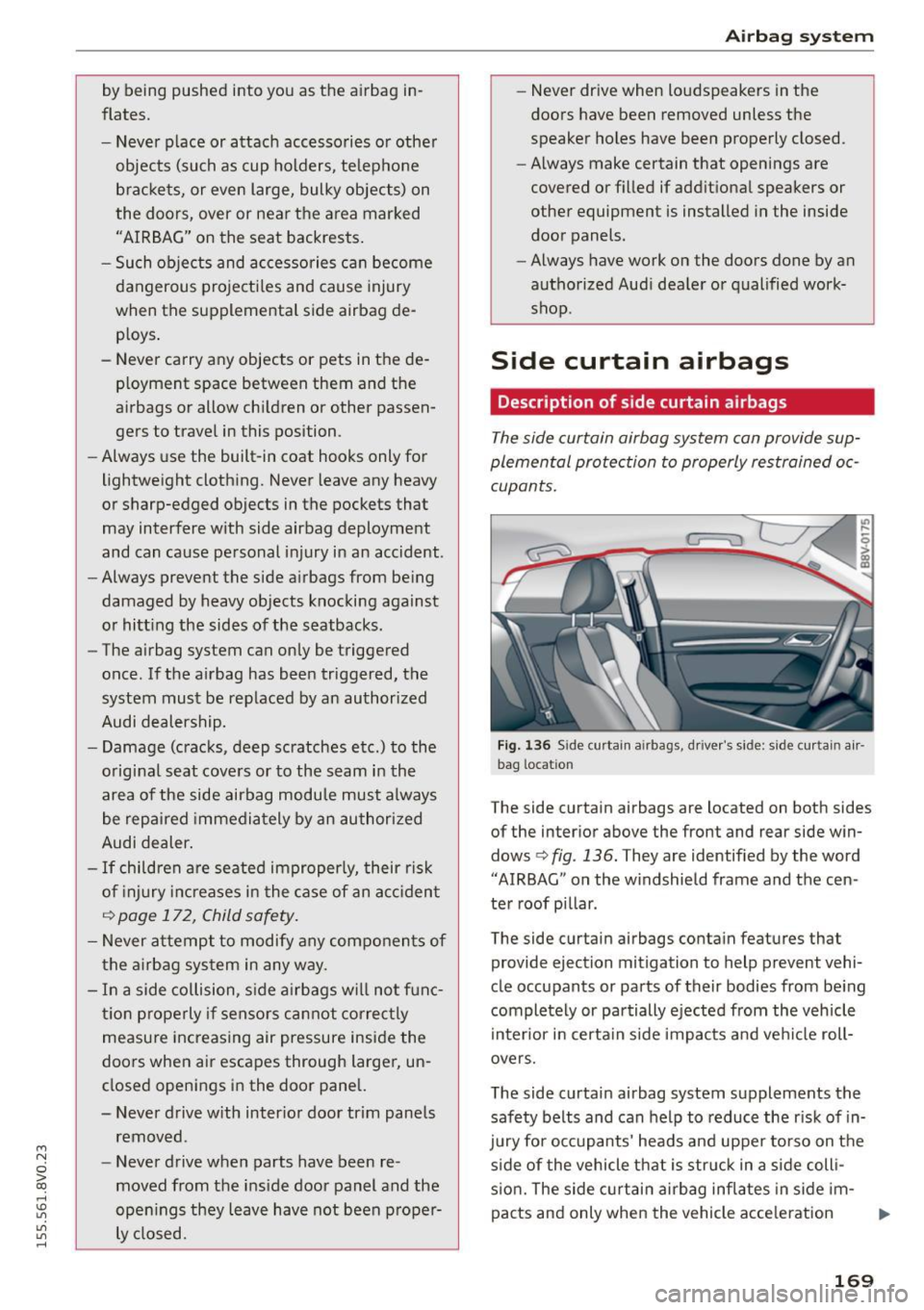
....,
N
0 > co
rl I.O
"'
"'
"'
rl
by being pushed into you as t he a irbag in
flates.
- Never p lace or attach accessories or other
objects (such as cup holders, te lephone
b rac ke ts, or even large, bulky objects) on
the doors, over or near t he area marked
"AIRBAG" on the seat backrests .
- Su ch ob jects and accessories can become
dangerous projecti les and cause injury
when the supplementa l side airbag de
ploys .
- Never carry any objects or pets in the de
p loyment space between them and the
airbags or allow children or other passen
gers to travel in this position.
- Always use the built-in coat hooks only for
lightweight clothing. Never leave any heavy
or sharp-edged objects in the pockets that
may interfere with side airbag deployment
and can cause personal injury in an accident .
- Always prevent the side a irbags from being
damaged by heavy objects knocking against
or hitt ing the sides of the seatbacks.
- The airbag system can only be triggered
once. If the a irbag has been triggered, the
system must be rep laced by an authorized
Audi dealership.
- Damage (cracks, deep scratches etc.) to the
o rigi nal seat cove rs or to the seam in the
area o f the side airbag module must always
be repaired immedia tely by an authorized
Audi dealer .
- If children a re seated improperly, their risk
of inj ury in crea ses in the case of an a ccident
c> page 172, Child safety.
-Never attempt to modify any compo nents of
the a irbag sys tem in any way.
- In a side collision, s ide a irbags will not func
t io n properly if senso rs ca nnot correctly
measu re increasing air pressure inside the
doors when air escapes through larger, un
closed openings in the door pane l.
- Never drive w ith inter ior door trim pane ls
removed.
- Never drive when parts have been re
moved from the ins ide door panel and the
open ings they l eave have not been p rope r
ly closed.
Ai rb ag system
- Never drive when lo udspeakers in the
doors have been removed unless the
speaker holes have been properly closed.
- Always make certain that openings are
covered or filled if additiona l speakers or
other equipment is installed in the inside
door panels.
- Always have work on the doors done by an
authorized Audi dealer or qualified work
shop.
Side curtain airbags
Description of side curtain airbags
The side curtain airbag system can provide sup
plemental protec tion to properly restrained oc
cupants.
Fig . 1 36 Side curtain a irbags , driver 's side: side cu rta in air
bag locat ion
The side curtain airbags are located on both sides
of the inter ior above the front and rear side w in
dows
c> fig . 136. They are identified by the word
"AIRBAG" on the windshield frame and the cen
te r roof pi llar .
The side curtain airbags conta in features that
provide ejection mitigation to help prevent vehi
cle occupants or parts of their bodies from being
completely or partially ejected from the vehicle
i nterior in certa in side impacts and ve hicle roll
overs.
T he side curtain airbag system supplements the
safe ty belts and can help to reduce the r isk of in
jury for occupants' heads and uppe r torso on the
s ide of the vehicle t hat is str uck in a side coll i
s io n. The side curtain airbag inflates in side im -
pacts and only when the vehicle acce leration
Ill--
169
Page 172 of 282
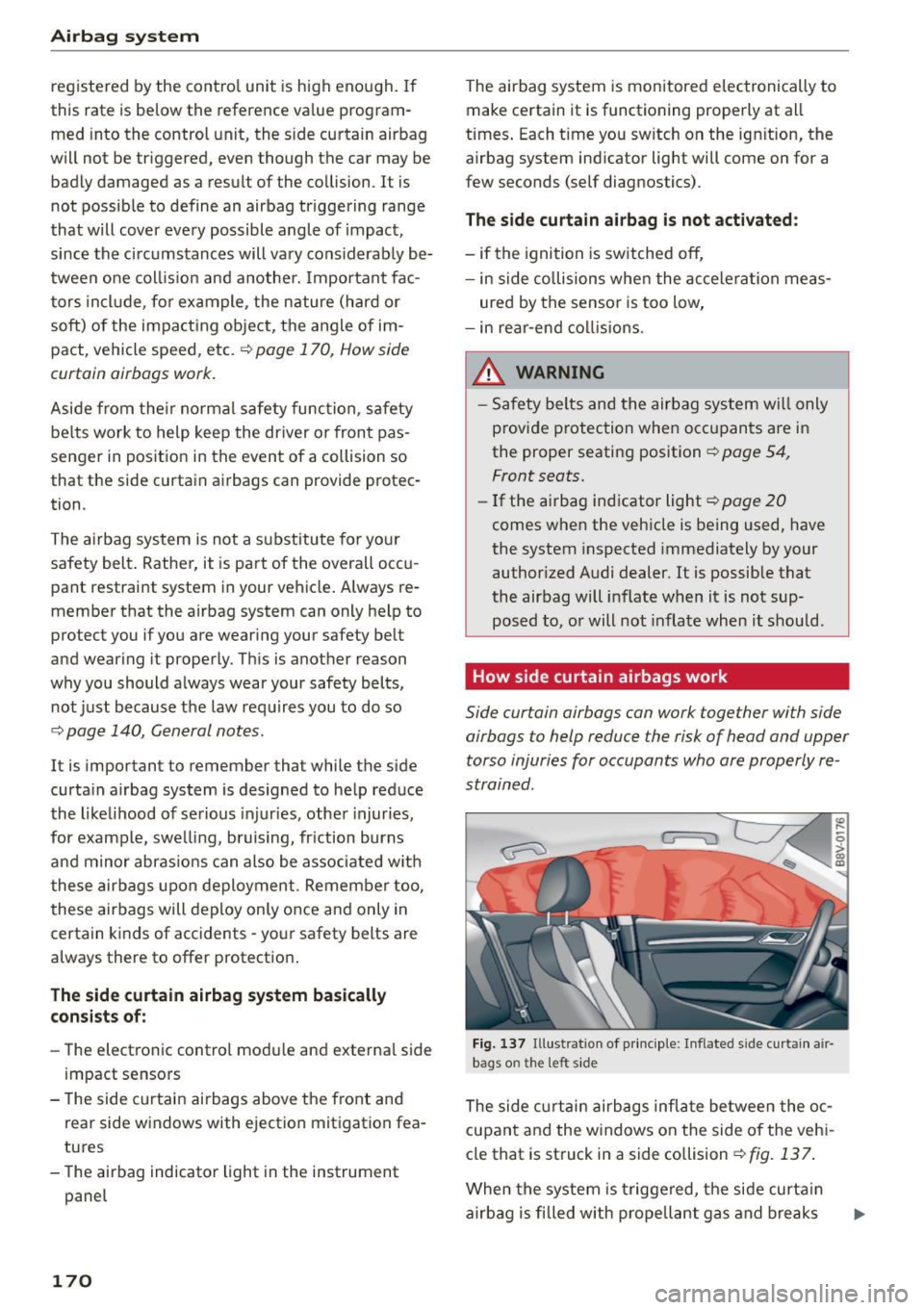
Airb ag syst em
registered by the cont ro l unit is high enough. If
this rate is below the reference va lue program
med into the control unit, the s ide curtain airbag
will not be triggered, even though the car may be
badly damaged as a result of the collision .
It is
not possib le to define an airbag triggering range
that will cover every possible angle of impact ,
since the circumstances will vary considerab ly be
tween one col lis ion and another. Important fac
tors include , for example , the nature (hard or
soft) of the impacting object, the angle of im
pact , vehicle speed, etc.
9 page 170, How side
curtain airbags work.
Aside from the ir normal safety function , safety
be lts work to help keep the driver or front pas
senger in position in the event of a collision so
that the side curtain airbags can provide protec
tion .
The airbag system is not a substitute for your
safety belt . Rather, it is part of the overall occ u
pant restraint system in your vehicle . Always re
member that the airbag system can only he lp to
protect you if you are wearing your safety belt
and wearing it properly . Th is is another reason
why you should a lways wear your safety belts,
not just because t he law requires you to do so
9 page 140, General notes.
It is important to remember that while the side
curta in a irbag system is designed to help reduce
the likelihood of serious injur ies, other injur ies,
for example, swe lling, bruising, fr iction burns
and minor abras ions can also be associated w it h
these airbags upon deployment . Remember too,
these airbags will deploy only once and only in
certain kinds of accidents -your safety belts are
always there to offer protection .
The side curt ain airbag sy stem basically
consist s of:
- The electronic control modu le and externa l side
impact sensors
- The side c urtain airbags above the fro nt and
rear side w indows with ejection mit igation fea
tures
- The airbag indicator light in the instrument
panel
170
The airbag system is monitored electronically to
make certain it is functioning properly at all
times . Each time you sw itch on the ign ition, the
airbag system ind icator light will come on for a
few seconds (self diagnostics).
The side curtain airbag i s not acti vat ed :
- if the ign ition is switched off,
- in side collisions whe n the accelera tion meas-
ured by the sensor is too low,
- in rear-end col lis ions .
.&_ WARNING
-Safety belts and the airbag system wi ll only
provide protection when occupants are in
the proper seating position
9 page 54,
Front seats.
- If the airbag indicator light~ page 20
comes when the vehicle is being used, have
the system inspected immediately by your
author ized Audi dealer.
It is possible that
the airbag will inflate when it is not sup
posed to, or will not infla te when it should.
How side curtain airbags work
Side curtain airbags can work together with side
airbags to help reduce the risk of head and upper
torso injuries for occupants who ore properly re
strained .
Fig. 137 Illust rat ion of prin cip le: I nflated s ide curtain a ir
bag s on t he le ft s ide
The side curtai n airbags infla te be tween the oc
cupant and the w indows on the side of the veh i
cle that is st ruck in a side collision~
fig. 137.
When the system is triggered, the side curta in
airbag is filled with prope llant gas and breaks
Page 173 of 282
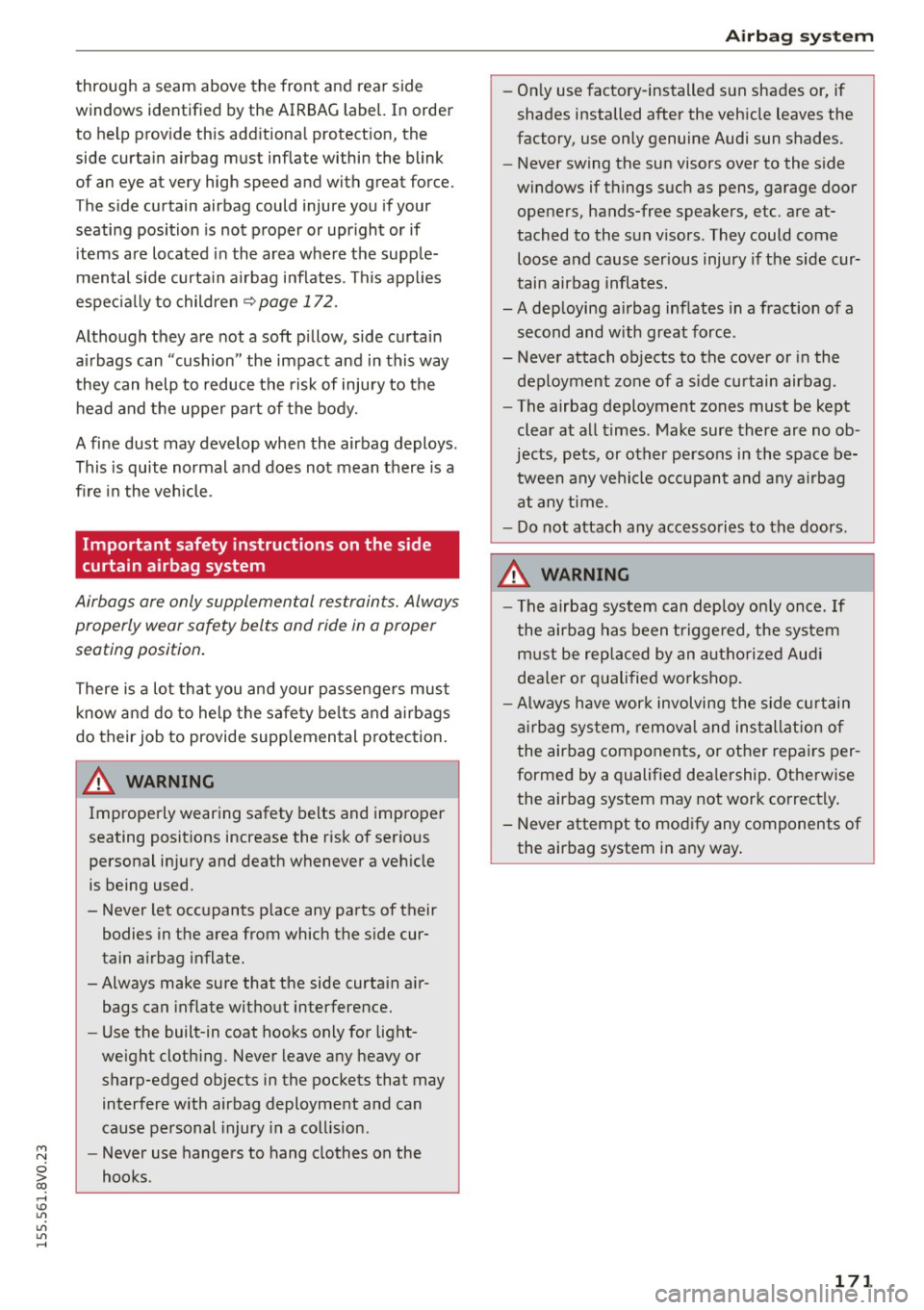
M N
0 > co ,...., \!) ..,.,
..,.,
..,., ,....,
through a seam above the front and rear side
windows identified by the AIRBAG label. In order
to help provide this additional protection, the
side curtain airbag must inflate within the blink
of an eye at very high speed and wi th great force.
T he side curtain airbag could injure you if your
seating position is not proper or upright or if
items are located in the area where the supple
mental side curtain airbag inflates . This applies
especially to children
q page 172 .
Although they are not a soft pillow, side curtain
airbags can "cushion " the impact and in this way
they can help to reduce the risk of injury to the
head and the upper part of the body.
A fine dust may develop when the airbag deploys.
This is quite normal and does not mean there is a
fire in the vehicle .
Important safety instructions on the side
curtain airbag system
Airbags are only supplemental restraints. Always
properly wear safety belts and ride in a proper
seating position.
There is a lot that you and your passengers must
know and do to help the safety belts and airbags
do their job to provide supplemental protection.
,&. WARNING
Improperly wearing safety belts and improper
seating positions increase the risk of serious
personal injury and death whenever a vehicle
is being used.
- Never let occupants place any parts of their bodies in the area from which the side cur
tain airbag inflate.
-Always make sure that the side curtain air bags can inflate without interference.
- Use the built-in coat hooks only for light
weight clothing . Never leave any heavy or
sharp-edged objects in the pockets that may
interfere with airbag deployment and can
cause personal injury in a collision.
- Never use hangers to hang clothes on the
hooks.
Airbag system
-Only use factory-installed sun shades or, if
shades installed after the vehicle leaves the
factory, use only genuine Audi sun shades.
- Never swing the sun visors over to the side
windows if things such as pens, garage door
openers, hands-free speakers, etc. are at
tached to the sun visors . They could come
loose and cause serious injury if the side cur
tain airbag inflates.
- A deploying airbag inflates in a fraction of a second and with great force .
- Never attach objects to the cover or in the deployment zone of a side curtain airbag .
- The airbag deployment zones must be kept
clear at all times. Make sure there are no ob
jects, pets, or other persons in the space be
tween any vehicle occupant and any airbag
at any time.
- Do not attach any accessories to the doors .
,&. WARNING
-- The airbag system can deploy only once. If
the airbag has been triggered, the system
must be replaced by an authorized Audi
dealer or qualified workshop.
- Always have work involving the side curtain
airbag system, removal and installation of
the airbag components, or other repairs per
formed by a qualified dealership. Otherwise the airbag system may not work correctly.
- Never attempt to modify any components of the airbag system in any way.
171
Page 174 of 282
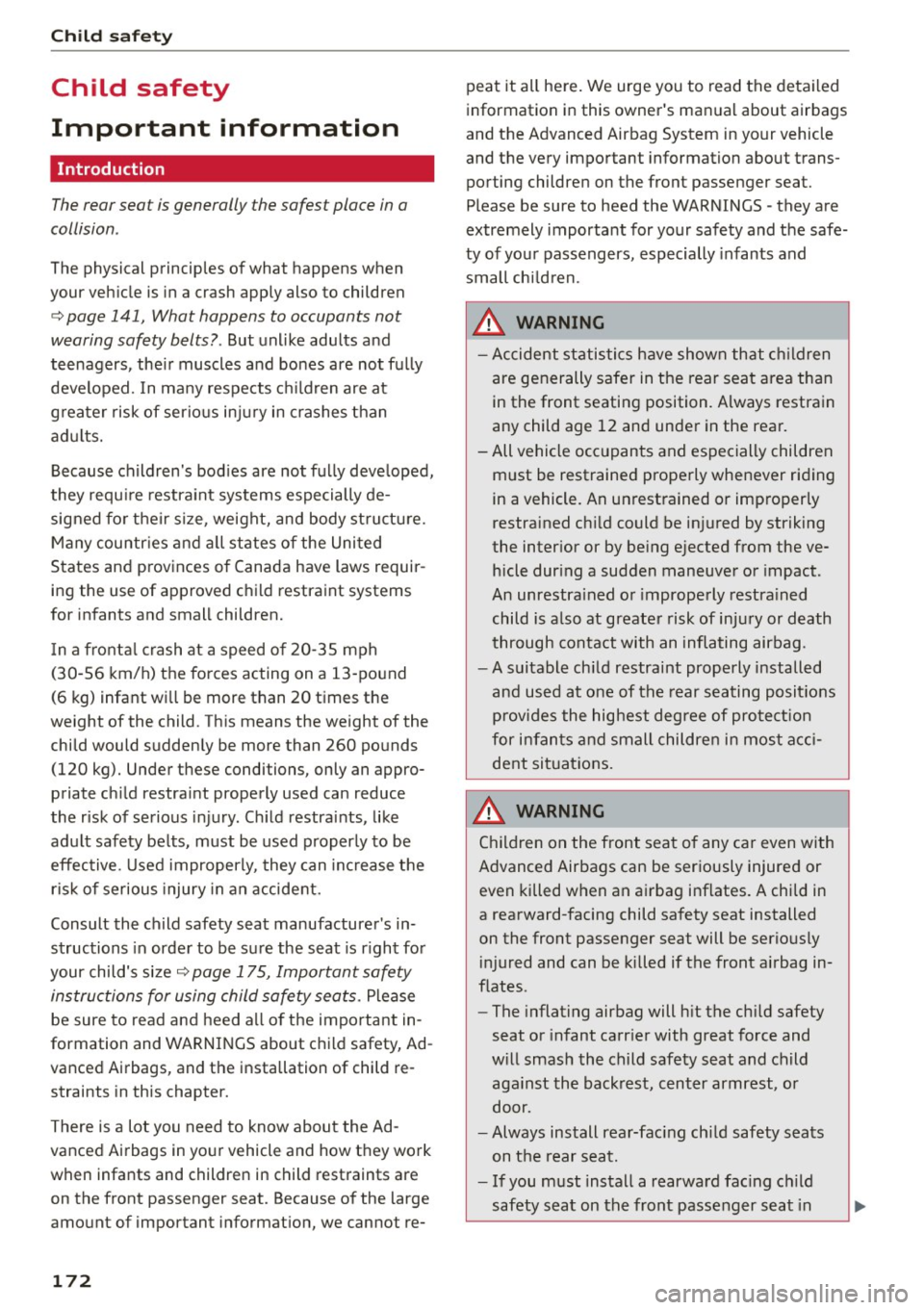
Child safety
Child safety
Important information
Introduction
The rear seat is generally the safest place in a
collision .
The physical principles of what happens when
your vehicle is in a crash apply also to children
¢ page 141, What happens to occupants not
wearing safety belts? .
But unlike adults and
teenagers, the ir muscles and bones are not fully
developed. In many respects children are at
g reater risk of serious injury in crashes than
adults.
Because children's bod ies are not fully deve loped,
they requ ire restra int systems especially de
signed for their size, weight, and body structure.
Many countr ies and all states of the United
States and provinces of Canada have laws requir
ing the use of approved c hild restraint systems
for infants and small children.
I n a fronta l crash at a speed of 20-35 mph
(30 -56 km/h) the forces acting on a 13 -pound
(6 kg) infant wi ll be more than 20 times the
weight of the child. This means the weight of the child would suddenly be more than 260 pounds
(120 kg). Under these conditions, only an appro
priate child restra int properly used can reduce
the r isk of serious injury . Ch ild restraints, like
adu lt safety be lts, must be used properly to be
effective. Used improperly, they can inc rease the
risk of serious injury in an accident.
Consult the child safety seat manufacturer's in
structions in order to be sure the seat is r ight for
your child's size¢
page 175, Important safety
instructions for using child safety seats .
Please
be sure to read and heed all of the important in
formation and WARNINGS about ch ild safety, Ad
vanced Airbags, and the installation of child re
straints in this chapter.
There is a lot you need to know about the Ad
vanced Airbags in your vehicle and how they work
when infants and children in child restraints are
on the front passenger seat. Because of the large
amount of important information, we cannot re-
172
peat it all here. We urge you to read the detailed
information in this owner's manua l about airbags
and the Advanced Airbag System in your vehicle and the very important information about trans
porting children on the front passenger seat.
Please be sure to heed the WARNINGS -they are
extremely important for your safety and the safe
ty of your passengers, especially infants and
small chi ld ren.
.&_ WARNING
- Accident statistics have shown that children
are generally safer in the rear seat area than
in the front seating position. Always restrain
any child age 12 and under in the rear.
- All vehicle occupants and especially children
m ust be restrained properly whenever riding
in a vehicle. An unrestrained or improperly restrained ch ild could be injured by striking
the inter ior or by be ing ejected from the ve
hicle dur ing a sudden maneuver or impact .
An unrestra ined or improperly restrained
child is a lso at greater risk of injury or death
through contact with an inflating airbag.
- A suitable ch ild restraint properly installed
and used at one of the rear seating posit ions
provides the highest degree of pro tect ion
for infants and small children in most acci
dent sit uations.
.&_ WARNING
Children on the front seat of any car even with
Advanced Airbags can be seriously injured or
even killed when an airbag inflates. A child in
a rearward-facing child safety seat installed
on the front passenger seat will be serious ly
injured and can be killed if the front airbag in
flates.
- The inflating airbag will h it the ch ild safety
seat or infant carr ier with great force and
w ill smash the child safety seat and child
aga inst the backrest, center armrest, or
door.
- Always install rear-fac ing ch ild safety seats
on the rear seat.
- If you must install a rearward fac ing ch ild
safety seat on the front passenger seat in
Page 175 of 282
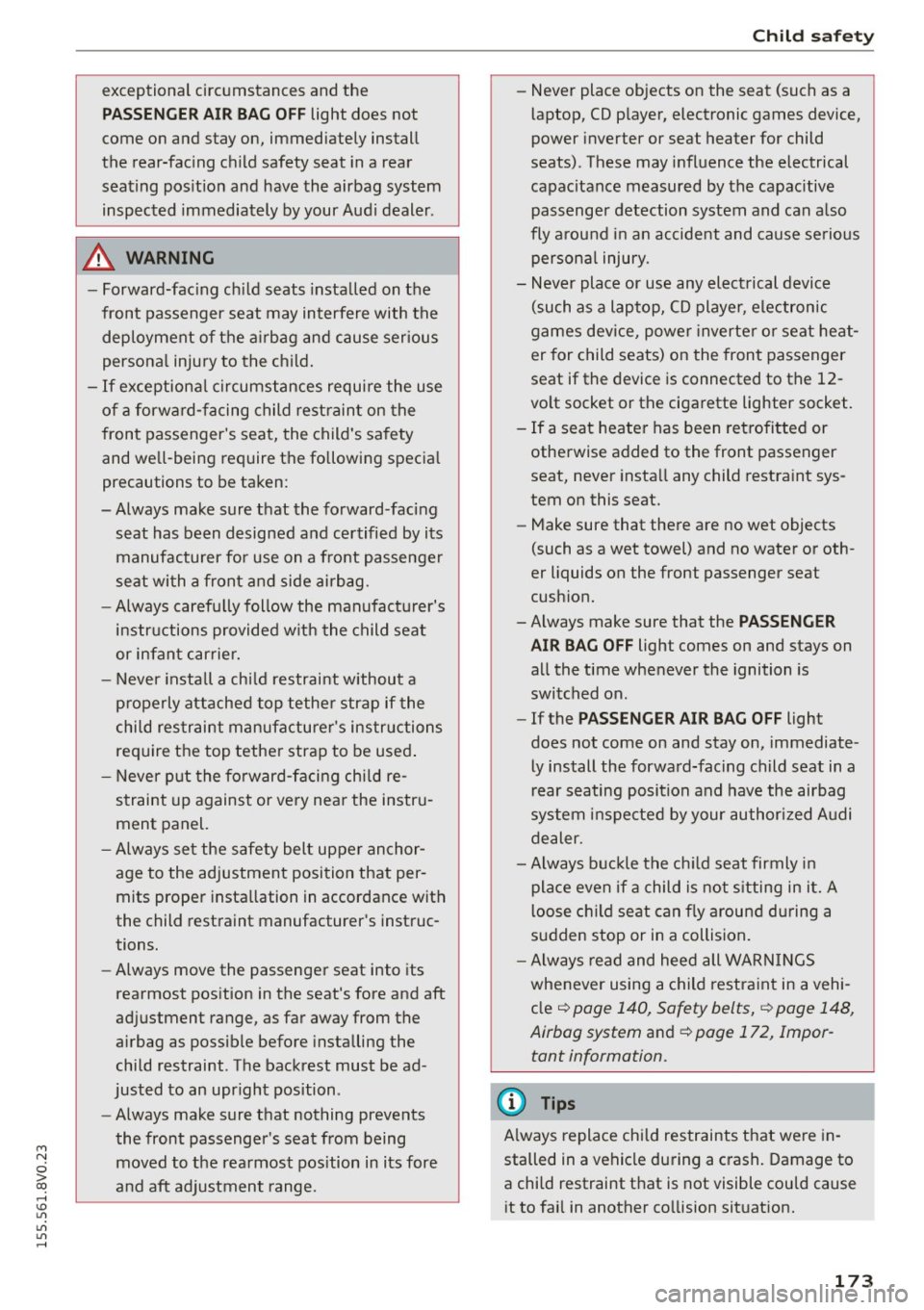
M N
0 > co ,...., \!) 1.1'1
1.1'1
1.1'1
,....,
exceptional circumstances and the
PASSENGER AIR BAG OFF light does not
come on and stay on, immediately install
the rear-facing child safety seat in a rear
seating position and have the airbag system
inspected immediately by your Audi dealer .
A WARNING
-Forward-facing child seats installed on the
front passenger seat may interfere with the deployment of the airbag and cause serious
personal injury to the child.
-If exceptional circumstances require the use
of a forward-facing child restraint on the
front passenger's seat, the child's safety
and well-being require the following special
precautions to be taken:
-Always make sure that the forward-facing seat has been designed and certified by its manufacturer for use on a front passenger
seat with a front and side airbag.
-Always carefully follow the manufacturer's
instructions provided with the child seat
or infant carrier.
- Never install a child restraint without a
properly attached top tether strap if the
child restraint manufacturer's instructions require the top tether strap to be used.
- Never put the forward-facing child re
straint up against or very near the instru
ment panel.
- Always set the safety belt upper anchor
age to the adjustment position that per
mits proper installation in accordance with
the child restraint manufacturer's instruc
tions.
- Always move the passenger seat into its
rearmost position in the seat's fore and aft
adjustment range, as far away from the
airbag as possible before installing the
child restraint . The backrest must be ad
justed to an upright position .
- Always make sure that nothing prevents
the front passenger's seat from being moved to the rearmost position in its fore
and aft adjustment range.
Child safety
-Never place objects on the seat (such as a
laptop, CD player, electronic games device,
power inverter or seat heater for child
seats) . These may influence the electrical
capacitance measured by the capacitive
passenger detection system and can also
fly around in an accident and cause serious
personal injury.
- Never place or use any electrical device
(such as a laptop, CD player, electronic
games device, power inverter or seat heat
er for child seats) on the front passenger
seat if the device is connected to the 12-
volt socket or the cigarette lighter socket.
- If a seat heater has been retrofitted or
otherwise added to the front passenger
seat, never install any child restraint sys
tem on this seat.
- Make sure that there are no wet objects
(such as a wet towel) and no water or oth
er liquids on the front passenger seat
cushion.
- Always make sure that the
PASSENGER
AIR BAG OFF
light comes on and stays on
all the time whenever the ignition is
switched on.
- If the
PASSENGER AIR BAG OFF light
does not come on and stay on, immediate
ly install the forward-facing child seat in a
rear seating position and have the airbag
system inspected by your authorized Audi
dealer.
- Always buckle the child seat firmly in
place even if a child is not sitting in it. A
loose child seat can fly around during a
sudden stop or in a collision.
- Always read and heed all WARNINGS
whenever using a child restraint in a vehi
cle
¢ page 140, Safety belts, ¢ page 148,
Airbag system
and ¢ page 172, Impor
tant information.
(D Tips
Always replace child restraints that were in
stalled in a vehicle during a crash. Damage to
a child restraint that is not visible could cause
it to fail in another collision situation.
173
Page 176 of 282
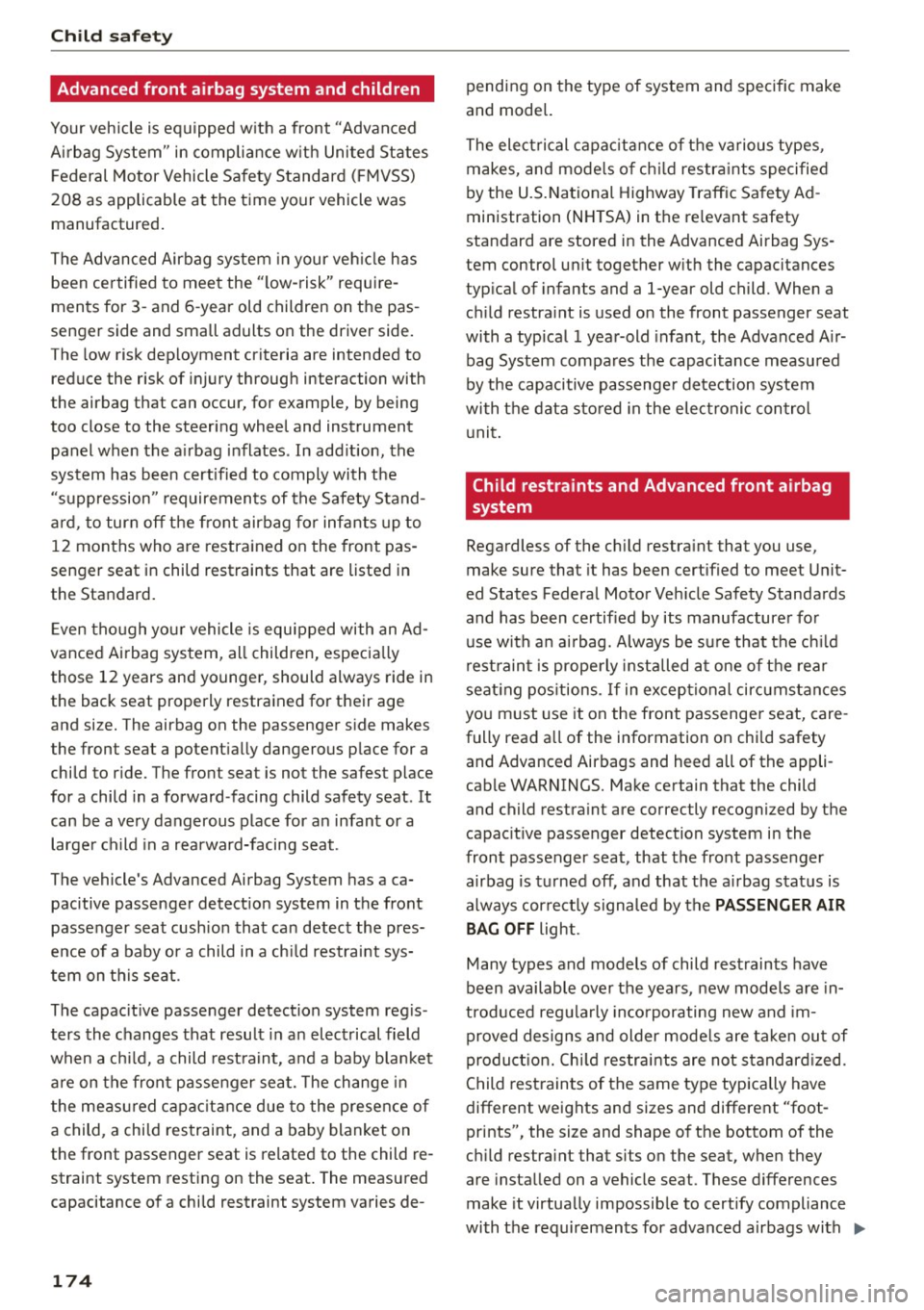
Child safety
Advanced front airbag system and children
Your vehicle is equipped with a front "Advanced
Airbag System" in compliance with United States Federal Motor Vehicle Safety Standard (FMVSS)
208 as applicable at the time your vehicle was
manufactured.
The Advanced Airbag system in your vehicle has
been certified to meet the "low-risk" require
ments for 3- and 6-year old children on the pas
senger side and small adults on the driver side.
The low risk deployment criteria are intended to
reduce the risk of injury through interaction with
the airbag that can occur, for example, by being
too close to the steering wheel and instrument panel when the airbag inflates. In addition, the
system has been certified to comply with the
"suppression " requirements of the Safety Stand
ard, to turn off the front airbag for infants up to
12 months who are restrained on the front pas
senger seat in child restraints that are listed in
the Standard.
Even though your vehicle is equipped with an Ad
vanced Airbag system, all children, especially
those 12 years and younger, should always ride in
the back seat properly restrained for their age
and size. The airbag on the passenger side makes
the front seat a potentially dangerous place for a
child to ride. The front seat is not the safest place
for a child in a forward-facing child safety seat .
It
can be a very dangerous place for an infant or a
larger child in a rearward-facing seat .
The vehicle's Advanced Airbag System has a ca
pacitive passenger detection system in the front
passenger seat cushion that can detect the pres
ence of a baby or a child in a child restraint sys
tem on this seat.
The capacitive passenger detection system regis
ters the changes that result in an electrical field
when a child, a child restraint, and a baby blanket
are on the front passenger seat. The change in
the measured capacitance due to the presence of
a child, a child restraint, and a baby blanket on
the front passenger seat is related to the child re
straint system resting on the seat. The measured
capacitance of a child restraint system varies de-
174 pending
on the type of system and specific make
and model.
The electrical capacitance of the various types, makes, and models of child restraints specified
by the U.S.National Highway Traffic Safety Ad
ministration (NHTSA) in the relevant safety
standard are stored in the Advanced Airbag Sys
tem control unit together with the capacitances
typical of infants and a 1-year old child. When a
child restraint is used on the front passenger seat
with a typical 1 year-old infant, the Advanced Air
bag System compares the capacitance measured
by the capacitive passenger detection system
with the data stored in the electronic control
unit.
Child restraints and Advanced front airbag
system
Regardless of the child restraint that you use,
make sure that it has been certified to meet Unit
ed States Federal Motor Vehicle Safety Standards
and has been certified by its manufacturer for
use with an airbag. Always be sure that the child
restraint is properly installed at one of the rear
seating positions. If in exceptional circumstances
you must use it on the front passenger seat, care
fully read all of the information on child safety
and Advanced Airbags and heed all of the appli cable WARNINGS. Make certain that the child
and child restraint are correctly recognized by the
capacitive passenger detection system in the
front passenger seat, that the front passenger airbag is turned off, and that the airbag status is
always correctly signaled by the
PASSENGER AIR
BAG OFF
light .
Many types and models of child restraints have
been available over the years, new models are in
troduced regularly incorporating new and im
proved designs and older models are taken out of
production. Child restraints are not standardized.
Child restraints of the same type typically have
different weights and sizes and different "foot
prints", the size and shape of the bottom of the
child restraint that sits on the seat, when they
are installed on a vehicle seat . These differences
make it virtually impossible to certify compliance
with the requirements for advanced airbags with ..,.
Page 177 of 282
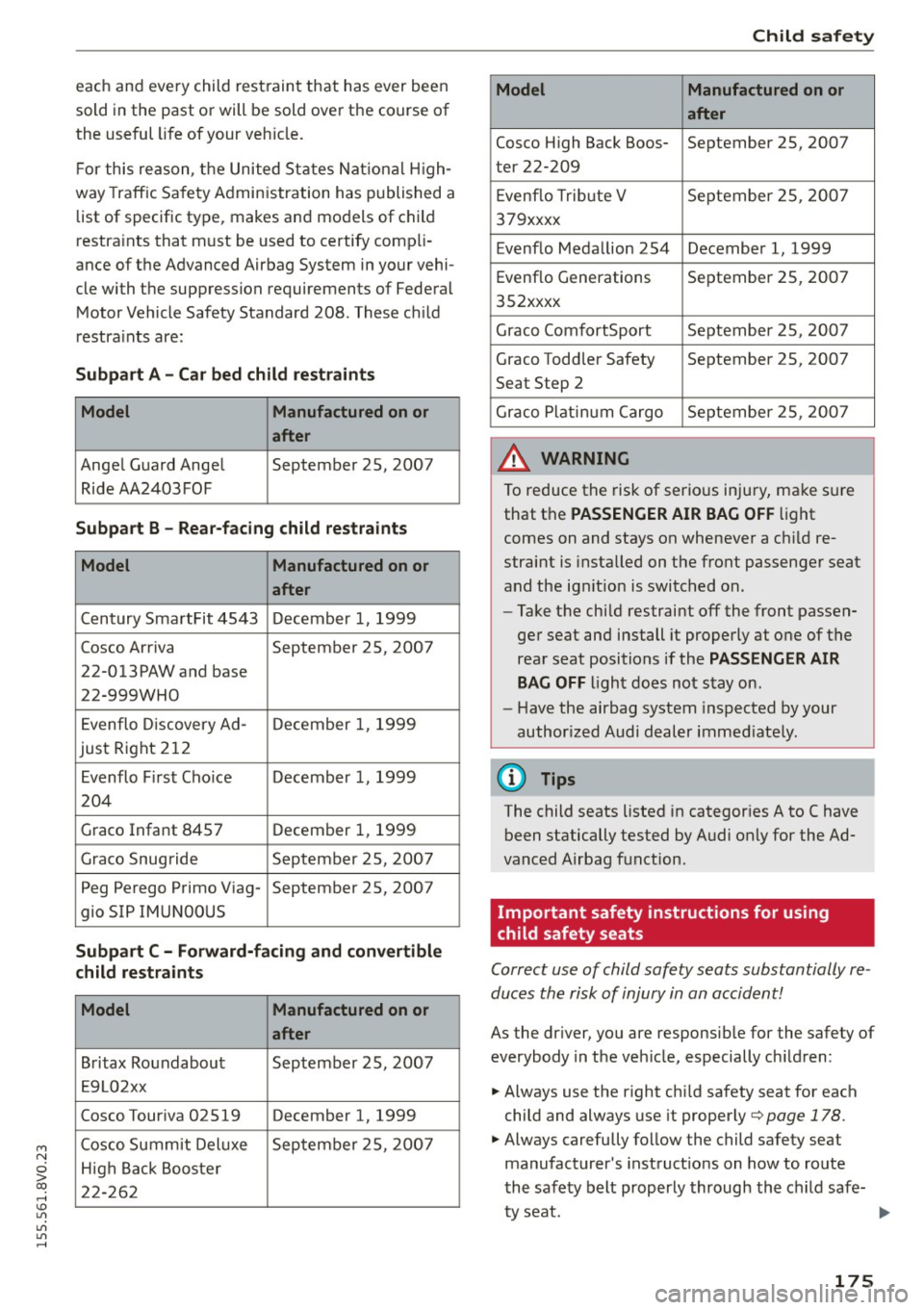
M N
0 > co ,...., \!) 1.1'1
1.1'1
1.1'1
,....,
each and every child rest raint that has ever been
sold in the past or will be sold over the course of
the useful life of your veh icle.
F or this reason, the United States Nat ional H igh
way Traffic Sa fety Admin istration has published a
list of specific type, makes and models of child
restra ints that must be used to certify compli
ance of the Advanced Airbag System in your vehi
cle with the suppression requirements of Federal
Motor Vehicle Safety Standard 208. These chi ld
restra ints are:
Subpart A - C ar bed child restraints
Model Manufactured on or
after
Angel Guard Ange l September 25, 2007
Ride AA2403FOF
Subp art B -Rear-facing child restraints
Model Manufactured on or
after
Century SmartFit 4543 December 1, 1999
C osco Arriva
September 25, 2007
22-013PAW and base
22-999WHO
E venflo D iscovery Ad-December 1, 1999
just Right 2 12
Evenflo F irst Cho ice December 1, 1999
204
Grace Infant 8457 December 1, 1999
Grace Snugride September 25, 2007
Peg Perego Primo V iag-
September 25, 2007
gio SIP IMUNOOUS
Subpart C - Forward-facing and conv ertible
child restraints
Model Manufactured on or
after
B ritax Roundabout Sept ember 25, 2007
E 9 L0 2xx
Cosco Touriva 02519 December 1, 1999
Cosco Summit Deluxe September 25, 2007
H igh Back Booster
2 2-262
Child sa fety
Model Manufactured on or
after
Cosco High Back Boos- September 25, 2007
ter 22-209
E venflo Trib ute V September 25, 200 7
379xxxx
Evenflo Meda llion 254 Decembe r 1, 1999
Evenflo Generations September 25, 2007
352xxxx
Graco ComfortSport September 25, 2007
Grace Toddler Safety September 25, 2007
Seat Step 2
Gr aco Plati num Cargo September 25, 200 7
A WARNING
To reduce the risk of serio us injury, make s ure
that the
PASSENGER AIR BAG OFF li ght
comes on and stays on whenever a ch ild re
straint is installed on the front passenger seat
and the ign it ion is switched on.
- Ta ke the chi ld restraint off the front passen
ger seat and install it properly at one of the
rea r seat positions if the
PASSENG ER AIR
BAG OFF ligh t does not stay on.
- Have the airbag system inspected by your
author ized Audi dealer immed iate ly.
(D Tips
The child seats listed in categor ies A to C have
been statically tested by Audi only for the Ad
vanced Airbag function.
Important safety instructions for using
child safety seats
Correct use of child safety seats substantially re
duces the risk of injury in an accident!
As the driver, you are responsible for the safety of
everybody in t he veh icle, especially ch ildren:
.. Always use the right child safety seat for each
child and always use it properly
¢ page 178 .
.. Always carefully follow the child safety seat
manufacturer's instruct ions on how to route
the safety belt properly through the c hild safe-
t y seat. .,,.
175
Page 178 of 282
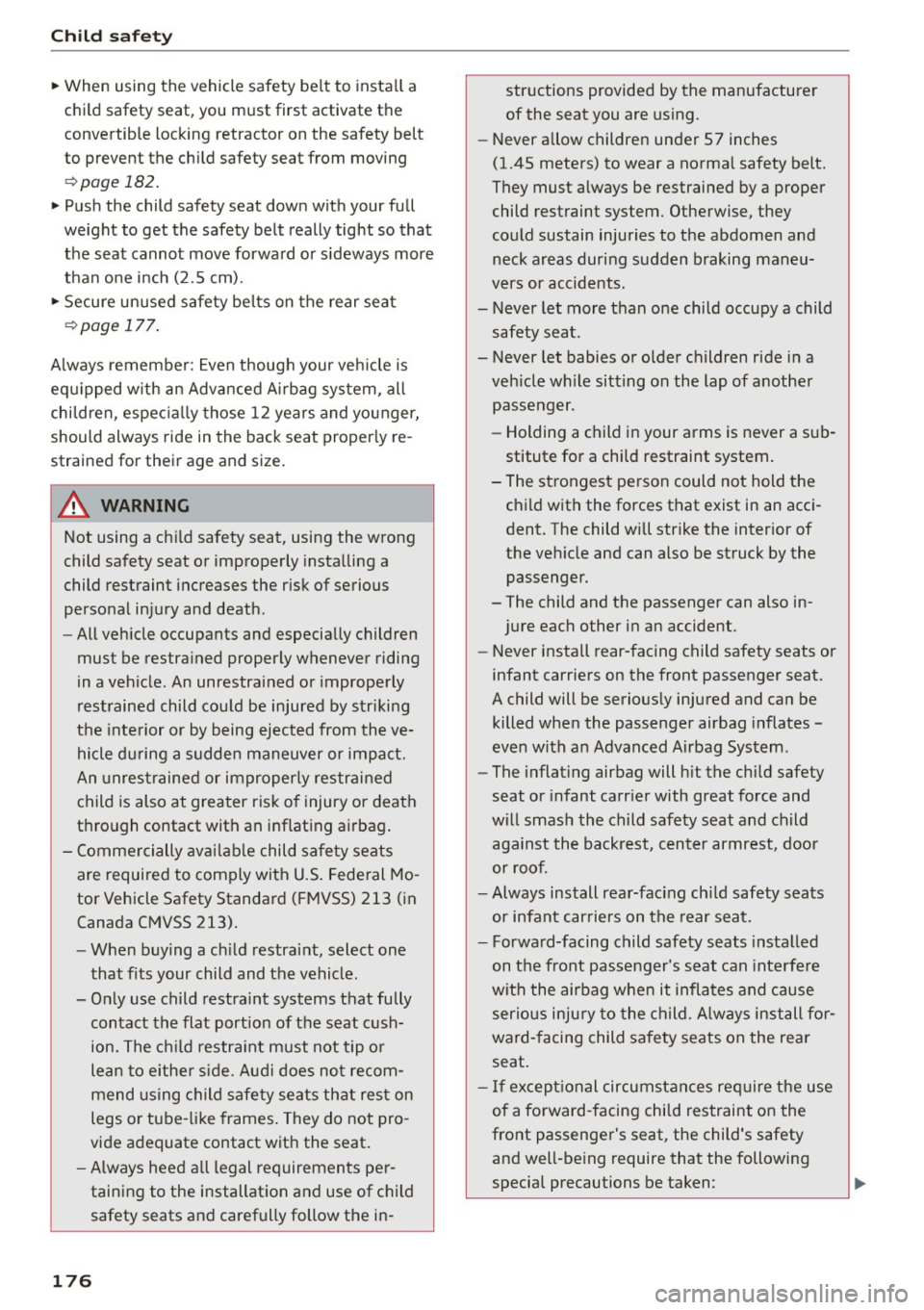
Child safet y
"'When using the vehicle safety be lt to insta ll a
child safety seat, you must first activate the
convertible locking retractor on the safety belt
to prevent the ch ild safety seat from moving
¢ page 182.
"' Push the child safety seat down with your full
weight to get the safety belt really tight so that
the seat cannot move forward or sideways more
than one inch (2.5 cm).
"' Secu re unused safety belts on the rear seat
¢ page 177 .
Always remember: Even thoug h your veh icle is
eq uipped w ith an Advanced Ai rbag system, all
chi ldren, espec ia lly those 12 years and yo unger,
should always ride in the back seat properly re
strained for their age and s ize.
A WARNING
Not using a chi ld safety seat, using the wrong
child safety seat or improperly insta lling a
child restraint increases the r isk of serious
personal injury and death .
- All veh icle occupants and especially children
must be restra ined properly whenever riding
in a vehicle. An unrestrained or improperly
restrained child could be injured by striking
the interior or by being ejected from the ve
hicle du ring a sudden maneuver or impact.
An unrestrained or improperly restrained
child is also at greater risk of injury or death
thro ugh contact with an inflat ing airbag .
- Commercially avai lab le child safety seats
are required to comply with U.S . Fede ral Mo
tor Vehicle Safety Standard ( FMVSS) 213 (in
Canada CMVSS 213).
- When buying a ch ild restraint, select one
that fits your child and the vehicle.
- On ly use child restra int systems that fully
contact the flat port ion of the seat cush
ion. The ch ild restra int must not tip o r
lean to either s ide. Audi does no t recom
mend using child safety seats that res t on
legs o r tube -like frames. They do not pro
vide adequate contact with the seat.
- Always heed all legal requirements pe r
taining to the installation and use of ch ild
safety seats and carefully follow the in-
176
str uctions provided by the manufacturer
of the seat you are using.
- Never allow children under 57 inches
(1.45 meters) to wear a norma l safety belt.
They must always be restrained by a proper
child restraint system. Otherwise, they
could sustain injuries to the abdomen and
neck areas during sudden braking maneu
vers or accidents.
- Never let more than one child occupy a child safety seat.
- Never let babies or o lder children ride in a
veh icle wh ile sitting on the lap of another
passenger .
- Holding a child in your arms is never a sub
stitute for a child restraint system.
- The strongest pe rson could not hold the
child with the forces that exist in an acci
dent. The child will strike the interior of
the veh icle and can also be struck by the
passenger.
- The child and the passenger can also in jure each other in an accident .
- Never install rear-facing child safety seats or
infant carriers on the front passenger seat.
A child will be serious ly injured and can be
killed when the passenger airbag inflates -
even with an Advanced Airbag System .
- The inflating airbag will h it the ch ild safety
seat or infant carr ier with great force and
will smash the child safety seat and child
aga inst the backrest, center armrest, door
or roof.
- Always install rear-facing ch ild safety seats
or infant car riers on the rear sea t.
- Forwa rd-facing child safety seats instal led
on the front passenger's seat can inte rfe re
wit h the airbag when it inflates and cause
serious injury to the child. A lways install fo r
ward-facing child sa fety seats on the rear
seat.
- If except ional circumstances req uire the use
of a fo rward-facing child restraint on the
front passenger's seat, the child's safety
and well-be ing require that the following
special precautions be taken : ..,.
Page 179 of 282
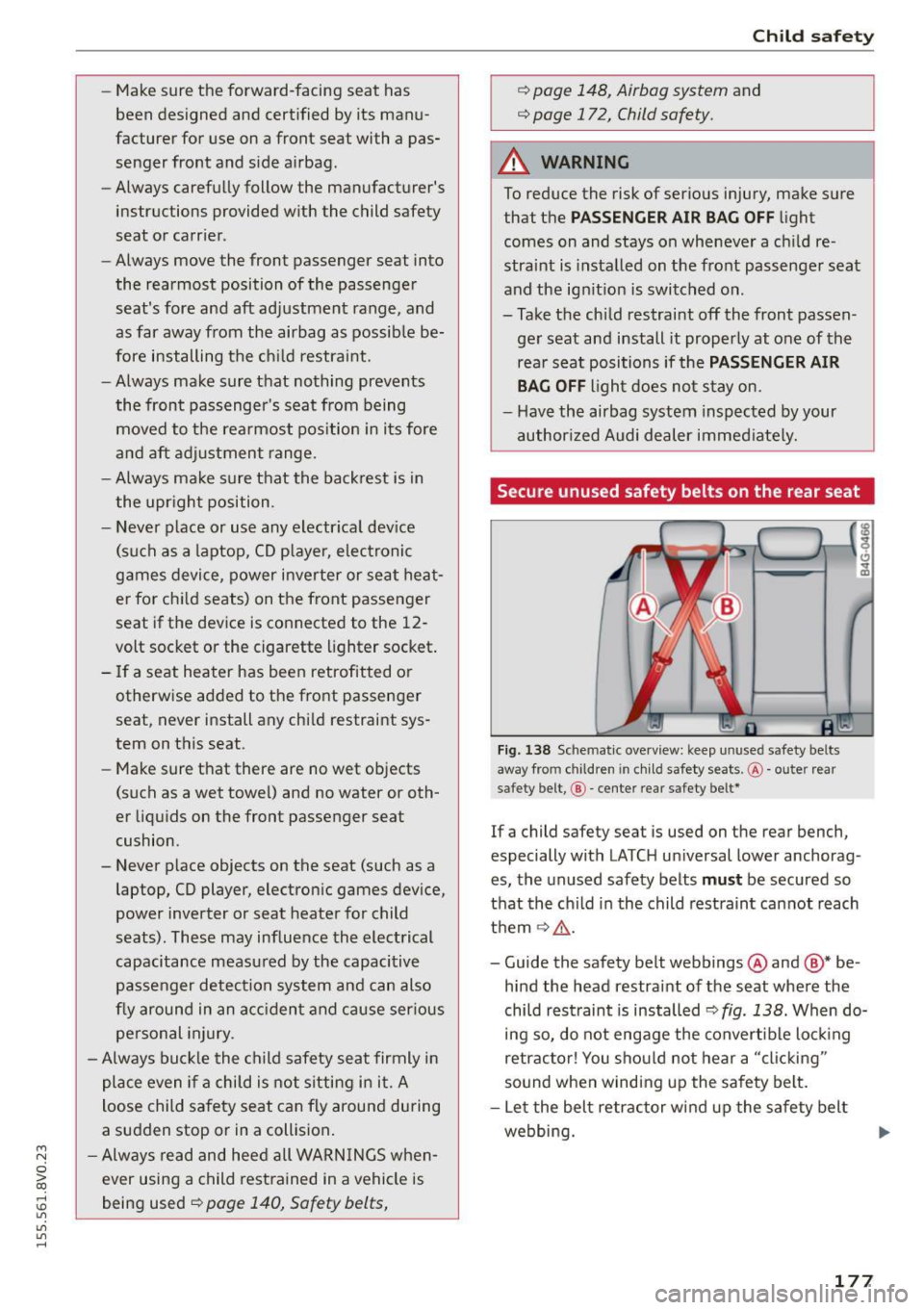
....,
N
0 > co
rl I.O
"'
"'
"'
rl
-Make sure the forward-facing seat has
been designed and certified by its manu
facturer for use on a front seat with a pas
senger front and side airbag.
- Always carefully follow the manufacturer's
instructions provided with the child safety
seat or carrier.
- Always move the front passenger seat into
the rearmost position of the passenger
seat's fore and aft adjustment range, and
as far away from the airbag as possible be
fore installing the child restraint.
- Always make sure that nothing prevents
the front passenger's seat from being
moved to the rearmost position in its fore
and aft adjustment range .
- Always make sure that the backrest is in
the upright position.
- Never place or use any electrical device
(such as a laptop, CD player, electronic
games device, power inverter or seat heat
er for child seats) on the front passenger
seat if the device is connected to the 12-
volt socket or the cigarette lighter socket.
- If a seat heater has been retrofitted or
otherwise added to the front passenger
seat, never install any child restraint sys
tem on this seat.
- Make sure that there are no wet objects
(such as a wet towel) and no water or oth
er liquids on the front passenger seat
cushion.
- Never place objects on the seat (such as a
laptop, CD player, electronic games device,
power inverter or seat heater for child
seats). These may influence the electrical
capacitance measured by the capacitive
passenger detection system and can also
fly around in an accident and cause serious
personal injury.
- Always buckle the child safety seat firmly in
place even if a child is not sitting in it. A
loose child safety seat can fly around during
a sudden stop or in a collision .
- Always read and heed all WARNINGS when
ever using a child restrained in a vehicle is
being used
¢ page 140, Safety belts,
Child safety
¢ page 148, Airbag system and
¢ page 172, Child safety.
A WARNING
-
To reduce the risk of serious injury, make sure
that the
PASSENGER AIR BAG OFF light
comes on and stays on whenever a child re
straint is installed on the front passenger seat
and the ignition is switched on.
- Take the child restraint off the front passen ger seat and install it properly at one of the
rear seat positions if the
PASSENGER AIR
BAG OFF
light does not stay on.
- Have the airbag system inspected by your
authorized Audi dealer immediately.
Secure unused safety belts on the rear seat
Fig. 138 Schematic overview: keep unused safety belts
away from children in c hild safety seats. @-outer rear
safety belt, @ -ce nter rear safety belt*
If a child safety seat is used on the rear bench,
especially with LATCH universal lower anchorag
es, the unused safety belts
must be secured so
that the child in the child restraint cannot reach
them ¢_& .
- Guide the safety belt webbings @and
®* be
hind the head restraint of the seat where the
child restraint is installed
¢ fig. 138. When do
ing so, do not engage the convertible locking
retractor! You should not hear a "clicking "
sound when winding up the safety belt.
- Let the belt retractor wind up the safety belt
webbing.
177
Page 180 of 282
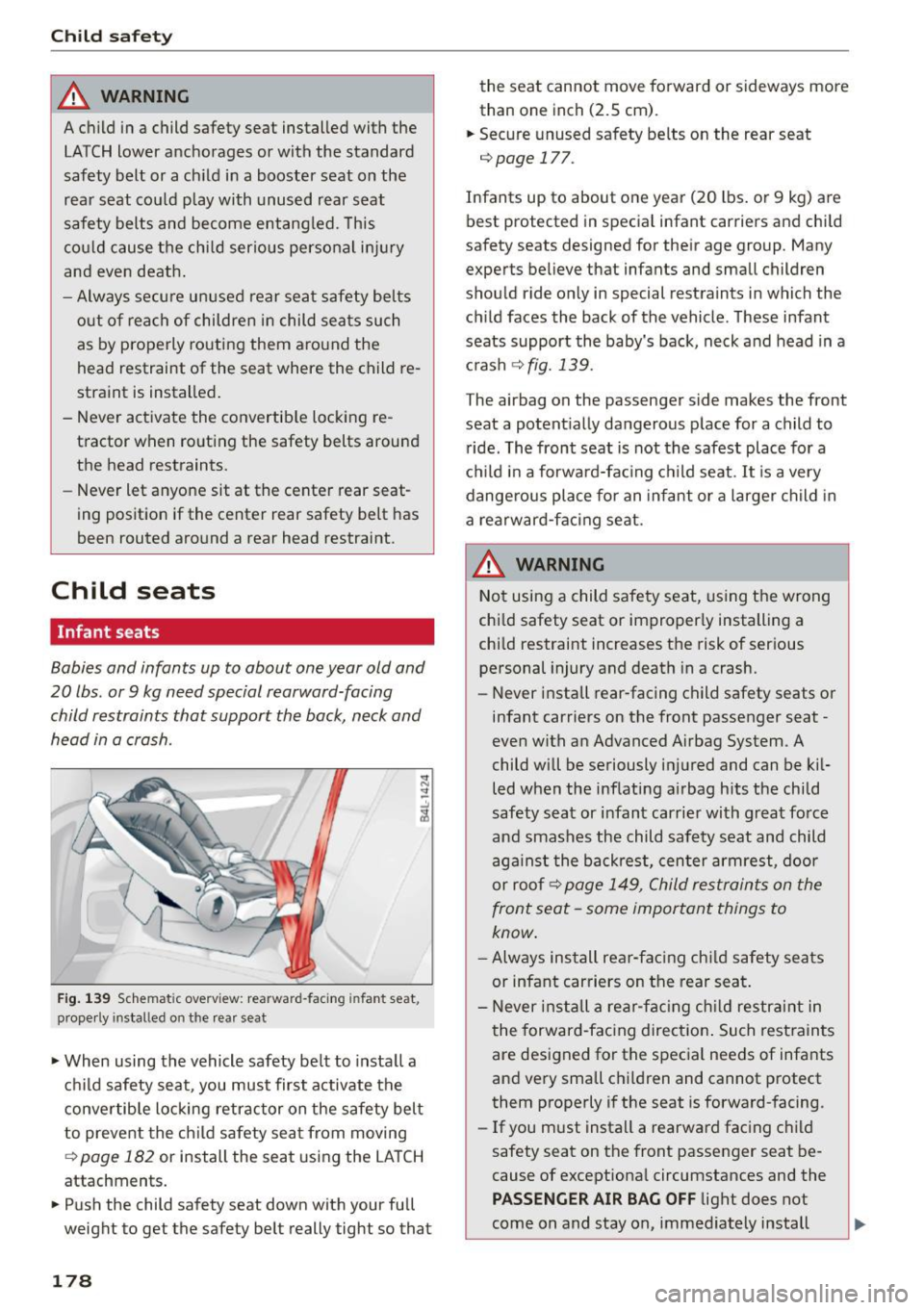
Child safety
_& WARNING
A child in a child safety seat installed with the LATCH lower anchorages or with the standard
safety belt or a child in a booster seat on the
rear seat cou ld play with unused rear seat
safety belts and become entangled. This
could cause the child serious personal injury
and even death.
- Always secure unused rear seat safety belts
out of reach of children in child seats such
as by properly routing them around the
head restraint of the seat where the child re
straint is installed.
- Never activate the convertible locking re tractor when routing the safety belts around
the head restraints.
- Never let anyone sit at the center rear seat
ing position if the center rear safety belt has
been routed around a rear head restraint.
Child seats
Infant seats
Babies and infants up to about one year old and
20 lbs. or 9 kg need special rearward-facing
child restraints that support the back, neck and
head in a crash.
Fig. 139 Schematic overview: rearward-facing infant seat,
properly installed on the rear seat
.. When using the vehicle safety be lt to install a
child safety seat, you must first activate the
convertible locking retractor on the safety belt
to prevent the child safety seat from moving
c::> page 182 or install the seat using the LATCH
attachments.
.. Push the child safety seat down with your full
weight to get the safety belt really tight so that
178
the seat cannot move forward or sideways more
than one inch (2.5 cm).
.. Secure unused safety belts on the rear seat
c::>page 177.
Infants up to about one year (20 lbs. or 9 kg) are
best protected in special infant carriers and child
safety seats designed for their age group. Many
experts believe that infants and small children
should ride only in special restraints in which the
ch ild faces the back of the vehicle. These infant
seats support the baby's back, neck and head in a
crash
c::> fig. 139.
The airbag on the passenger side makes the front
seat a potent ially dangerous place for a child to
ride . The front seat is not the safest place for a
child in a forward-facing ch ild seat.
It is a very
dangerous place for an infant or a Larger child in
a rearward-facing seat.
_& WARNING
Not using a child safety seat, using the wrong
child safety seat or improperly installing a
child restraint increases the risk of serious personal injury and death in a crash.
- Never install rear-facing child safety seats or
infant carriers on the front passenger seat -
even with an Advanced Airbag System. A
child will be seriously injured and can be kil led when the inflating airbag hits the child
safety seat or infant carrier with great force
and smashes the child safety seat and child
against the backrest, center armrest, door
or roof
c::> page 149, Child restraints on the
front seat -some important things to
know .
-Always install rear-facing chi ld safety seats
or infant carriers on the rear seat.
- Never install a rear-fac ing ch ild restraint in
the forward-facing direction. Such restraints
are designed for the special needs of infants
and very small children and cannot protect
them properly if the seat is forward-facing.
- If you must install a rearward facing child
safety seat on the front passenger seat be
cause of exceptional circumstances and the
PASSENGER AIR BAG OFF light does not
come on and stay on, immediately install
~